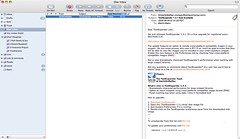Merlin’s weekly podcast with Dan Benjamin. We talk about creativity, independence, and making things you love.
LinksWidescreen Mail.app plug-inMerlin Mann | Jun 6 2006
As the monitors in my life have gotten wider, I've longed for a Mail.app feature that's baked-in to most other Mac email apps and RSS readers (as well as all the Microsoft email clients I'm aware of): the three-paned, widescreen format. Prayers apparently have been answered in the affirmative with harnly.net's Widescreen Mail.app plugin. On my 1440x900 MacBook Pro this works great, but it's truly a godsend on my ginormous (and beloved) Dell UltraSharp.
6 Comments
POSTED IN:
Study: Brits blow 2hrs/day on inefficient tech communicationMerlin Mann | Jun 5 2006[Misuse of office technology adds more than two hours to the average British working day] Couldn't track down the source material from the UK productivity study referenced in this press release, but, if they're accurate, some of the data are interesting to say the least.
Seems conservative to me, but -- you know -- I'm a terrific karmasuck about these things. Also intriguing are these bullets on "average times wasted each day:" read more »POSTED IN:
Self-help addiction a $8.5B/year businessMerlin Mann | Jun 5 2006I remember thinking a lot of these same thoughts during the self-help mini-bubble of the late 80s/early 90s.
POSTED IN:
Evergreen advice on email and voicemailMerlin Mann | May 30 2006Managing the Trend Toward Increasing Use of Electronic Messaging Tools I've been Googling around for good advice on how people deal with "email overload," and I think this 1999 report from the CommCore Consulting Group may contain some of the more sound and evergreen advice out there for not contributing to the noise (cf: "Writing sensible email messages"). It covers etiquette and best practices for both voicemail and email. Some of the best tips on email:
And on voicemail: read more »POSTED IN:
Matthieu Ricard symposium at UCSF tomorrowMerlin Mann | May 18 2006UCSF - Calendar of Events [Symposium on Happiness with Matthieu Ricard] I’m looking forward to attending this symposium with the Mrs. tomorrow night on the campus of UCSF. Open to the public and maybe worth checking out if you share my interest in mindfulness and exploring Dharma practice.
POSTED IN:
Richard Kuo: Getting Outlook to clam the heck upMerlin Mann | May 9 2006Richard Kuo's Personal Blog : Optimize your life #3 - how to manage e-mail effectively (1/2) Richard Kuo posts on email efficiency are quite good and cover a few of the best practices for managing your crazy email world (a few of which I covered as well in Inbox Zero). I bring it up here because one of his articles walks you through screengrabs explaining how to shut off noisome auto-check and notifications options in Outlook. read more »POSTED IN:
The Fisher Space Pen: Arglebargle or Fufurah?Merlin Mann | May 8 2006The Space Review: The billion-dollar space pen Knowing I'm such a huge nerd for space pens (previously), it's not surprising that I get a couple emails a month from gloaty people pointing to the high-larious anecdote about how Paul Fisher's write-anywhere pen represents one of the 1960s' greatest boondoggles of government waste and gold-plating. "Ha!" they note exclamation-pointedly, "these geniuses over at NASA spent [insert boondoggle-y dollar figure of at least $1,000,000] to develop a pen that could write in space. Know what the freakin' Russians used?!? A pencil, dude! A pencil!" Like I say: hilarious. Setting aside for a moment whether this disturbing cautionary tale from forty years hence has any bearing on how well the space pen works as advertised for consumers today, the story has its minor failings; it's kind of untrue and not a little misleading. Apparently, pencils were once used by both sides in the Space Race, but they were reasoned a hazard based on the catastrophic possibilities of tiny broken leads whizzing around in zero gravity. So, as soon as the Space Pen became available and was tested for suitability, it seems the U.S. (as well as, evidently, the Russians) abandoned pencils for good from 1968 on. Anyhow, to my knowledge, any development money for the pen came straight out of Paul Fisher's pocket -- not from NASA nor any other government agency. I'd known some of this for years, and, of course, have always relished tinkling in readers' bowls of smug by providing the debunking/clarifying Snopes link. What I didn't know until today was the the whole story behind Paul Fisher's ambitious entry into the space age writing economy. It's a fascinating mix of engineering, marketing, and blatant self-promotion that tangentially involves baloney sandwiches, a diamond ring, and a brassiere: read more »POSTED IN:
David Sedaris, and the stuff we do and don't buy ourselvesMerlin Mann | May 5 2006Another, as usual, hilarious New Yorker essay from David Sedaris. Mentioned here, first, because of his opening paragraph, which reveals David's personal method for "ubiquitous capture": read more »POSTED IN:
Mindfulness, categories, and the 14 kinds of animalsMerlin Mann | May 3 2006List of animals (Borges) - Wikipedia, the free encyclopedia I've been enjoying a wonderful book that a reader thoughtfully sent to me a couple weeks ago. It's called Mindfulness, and it presents some fascinating evidence on the ways that we process and parse our world, as well as the peculiarly human things that can happen when we unintentionally (natch) embrace mindlessness. read more »POSTED IN:
Greg Knauss on personal "info-glut"Merlin Mann | May 3 2006Daunted by the rising piles of "info-glut." Greg decides to pare down. read more »POSTED IN:
|
|
| EXPLORE 43Folders | THE GOOD STUFF |

